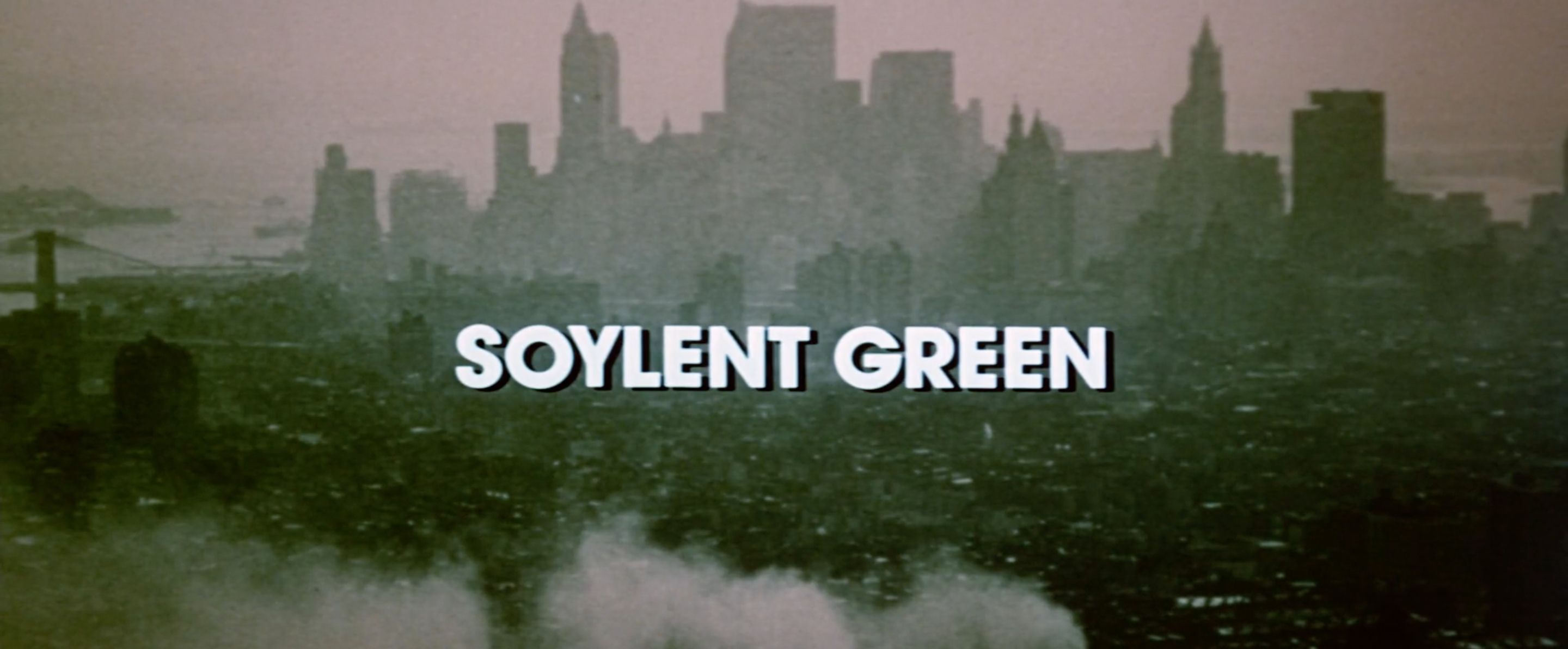 Inevitably, there are spoilers here, but if you’ve really never been spoiled on the big final twist of Soylent Green, then stop here, consider yourself blessed, and go watch it. There really isn’t much else to “spoil” in this movie, but nevertheless, I’ve tried to keep spoilers to a minimum. As always, read with care. Thanks!
Inevitably, there are spoilers here, but if you’ve really never been spoiled on the big final twist of Soylent Green, then stop here, consider yourself blessed, and go watch it. There really isn’t much else to “spoil” in this movie, but nevertheless, I’ve tried to keep spoilers to a minimum. As always, read with care. Thanks!
What is it? Soylent Green, directed by Richard Fleischer, screenplay by Stanley R. Greenburg (based on the novel by Make Room! Make Room! by Harry Harrison), and starring Charlton Heston, Edward G. Robinson, Chuck Connors, Leigh Taylor-Young, and Joseph Cotten.
First viewing? Yes, for once!
What’s it about? In 2022, the world’s population has exploded and the natural world has been devastated. Once common items like meat and fresh vegetables and jam are now incredibly scarce. In New York, where families routinely sleep on brownstone staircases and riots are a daily occurence, a police detective (Heston) investigates the murder of a corporate executive (Cotten), discovering a conspiracy around a mass-produced foodstuff called soylent green.
What are your thoughts about it? So my understanding — and I don’t know if this is true or not — is that Soylent Green is considered a camp classic, primarily because of the twist, possibly the most spoiled twist outside of Planet of the Apes and The Sixth Sense. I am here to tell you there is nothing campy about this movie, and anyone who tells you otherwise either hasn’t seen it or has terrible taste. This is one of the all-time great Feel Bad movies, and in decade with a lot of contenders, probably the most archetypal “depressing ’70s ending.” Watching it in 2022, the year it takes place, was a harrowing experience.
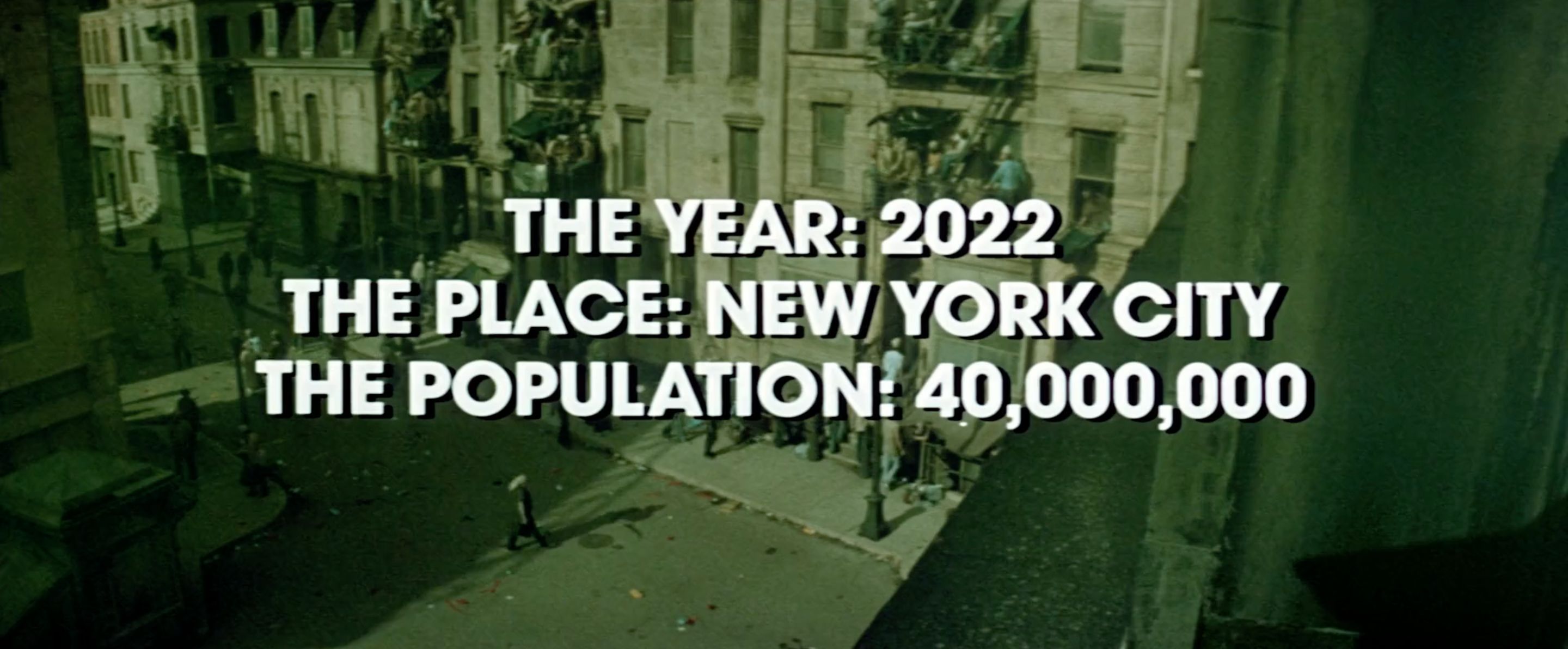 This is giving me major 2022 vibes.
This is giving me major 2022 vibes.
One reason the film works as well as it does is because of the worldbuilding involved. Now, I’m not that big a fan of worldbuilding, in and of itself, in either films or rpgs. I don’t give a shit about Middle Earth aside from whether Frodo is going to set up them the ring. I run a D&D campaign, and there’s just enough “world” outside the character spotlight to be convincing. (I hope.) The best cinematic worldbuilding is The Matrix, and every moment of it is so deeply tied to character and story it barely registers as such. Worldbuilding usually means history, and history without a story context is a waste of time.
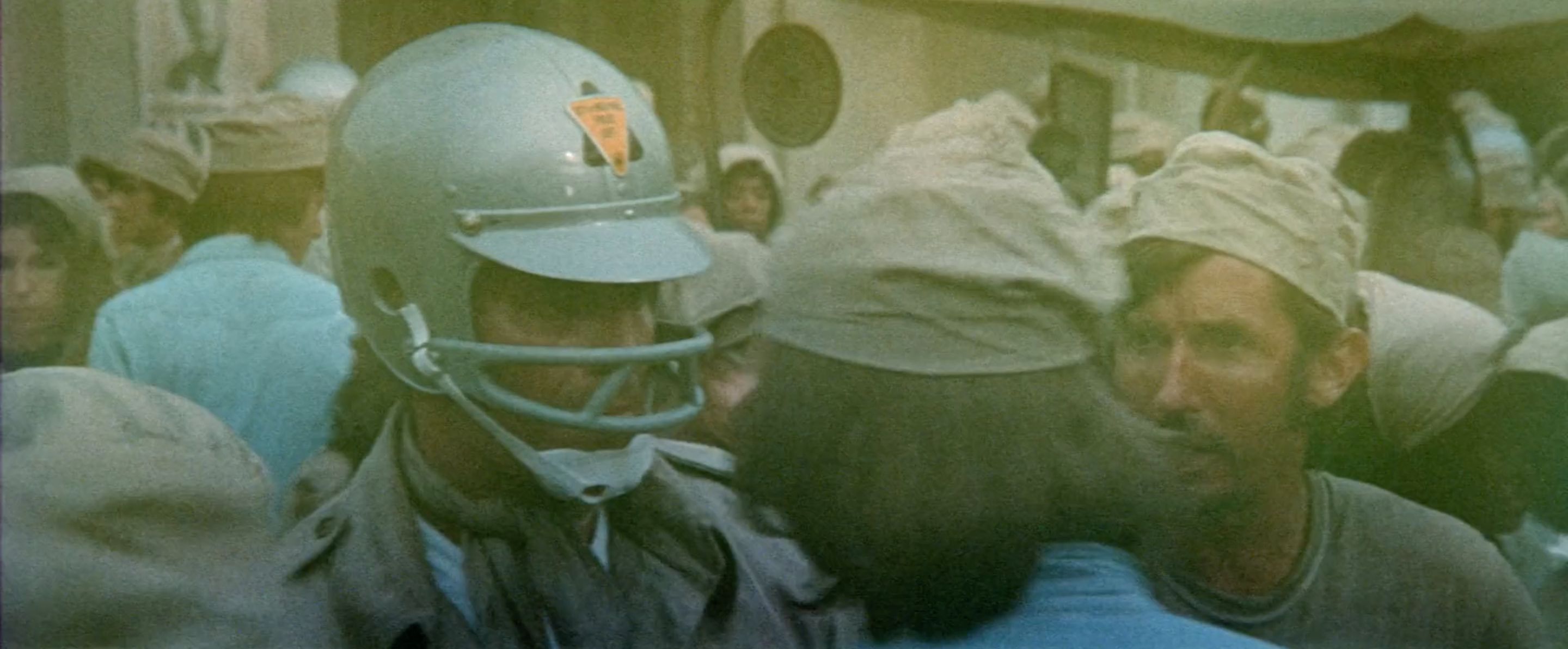 Here’s a bit of unexplained worldbuilding. Why do the police wear modified football helmets? I don’t know and I don’t want to know. Accept the mystery.
Here’s a bit of unexplained worldbuilding. Why do the police wear modified football helmets? I don’t know and I don’t want to know. Accept the mystery.
That said, the worldbuilding in Soylent Green is phenomenal. Worldbuilding should be about presenting ideas and situations that are beyond most people’s experience. The further away it is from modern day experience (say with elves and dragons and magic), the more worldbuilding is required. The one weird trick in making it work is to explain it as little as possible; otherwise, it’s just exposition1. There are so many amazing details in Soylent Green that go mostly unexplained, but seem clear enough from context: the seemingly-endless staircases filled with sleeping bodies; the armed citizens standing guard at the top of those stairs; the shockingly clean and futuristic suicide centers; the “furniture.” The most subversive part is how Heston’s police detective brazenly takes whatever he wants from the dead executive’s luxurious apartment, blurring the line between corruption and survival. Some might say the mystery at the center of the film is undeveloped and pedestrian; I say it’s merely the throughline by which to observe and experience this reality.
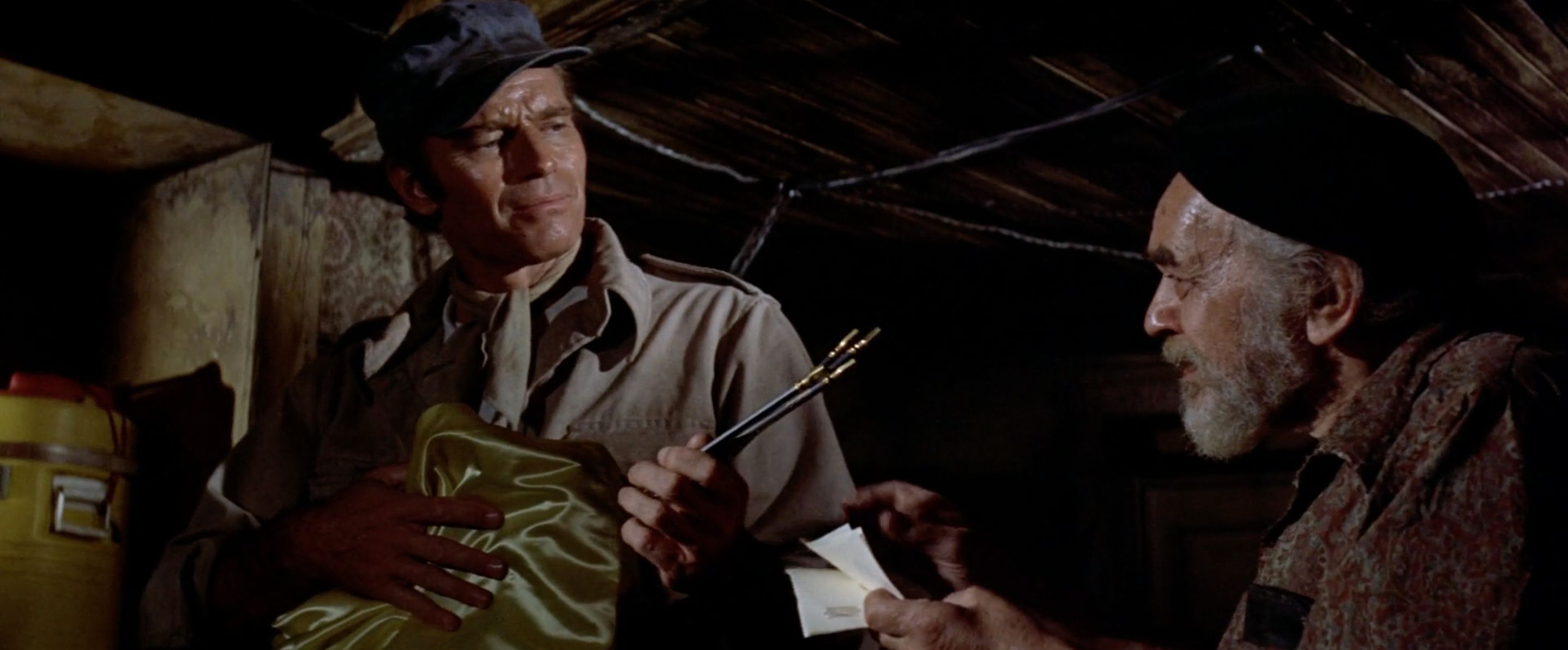 It wasn’t until I was composing this post that I realized that Heston’s crappy apartment, which doesn’t have electricity or running water, that he shares with a co-worker (who, thankfully, is also a friend and father figure), is basically upper middle class lodging in this world.
It wasn’t until I was composing this post that I realized that Heston’s crappy apartment, which doesn’t have electricity or running water, that he shares with a co-worker (who, thankfully, is also a friend and father figure), is basically upper middle class lodging in this world.
Another (idiosyncratic) reason it’s so effective is a counterintuitive one. Soylent Green was released in 1973, and big budget filmmaking techniques were still rooted in the ’60s: large sets on studio backlots, a lot of medium shots in wide rooms where a camera pans to follow a character across space, almost no handheld shots. (That description probably sounds so generic as to apply to any movie, but that’s a failure of my facility with language. What I’m talking about really is specific to a Hollywood style that runs from the ’40s to the early ’70s, including ’70s TV.) It’s the same cinematic language used in, for example, romantic comedies of the ’50s and ’60s. 1970s movies that look like this are a bit creaky through today’s eyes, with one foot in the past and the other foot not quite in the future. (A lot of these movie also have these sets that are lit like they’re The Godfather but then use these dingy greens and browns for the interiors. See also Logan’s Run, Damnation Alley, Bug, and Night Gallery. I want to say it’s a Universal thing but it cuts across studios.)
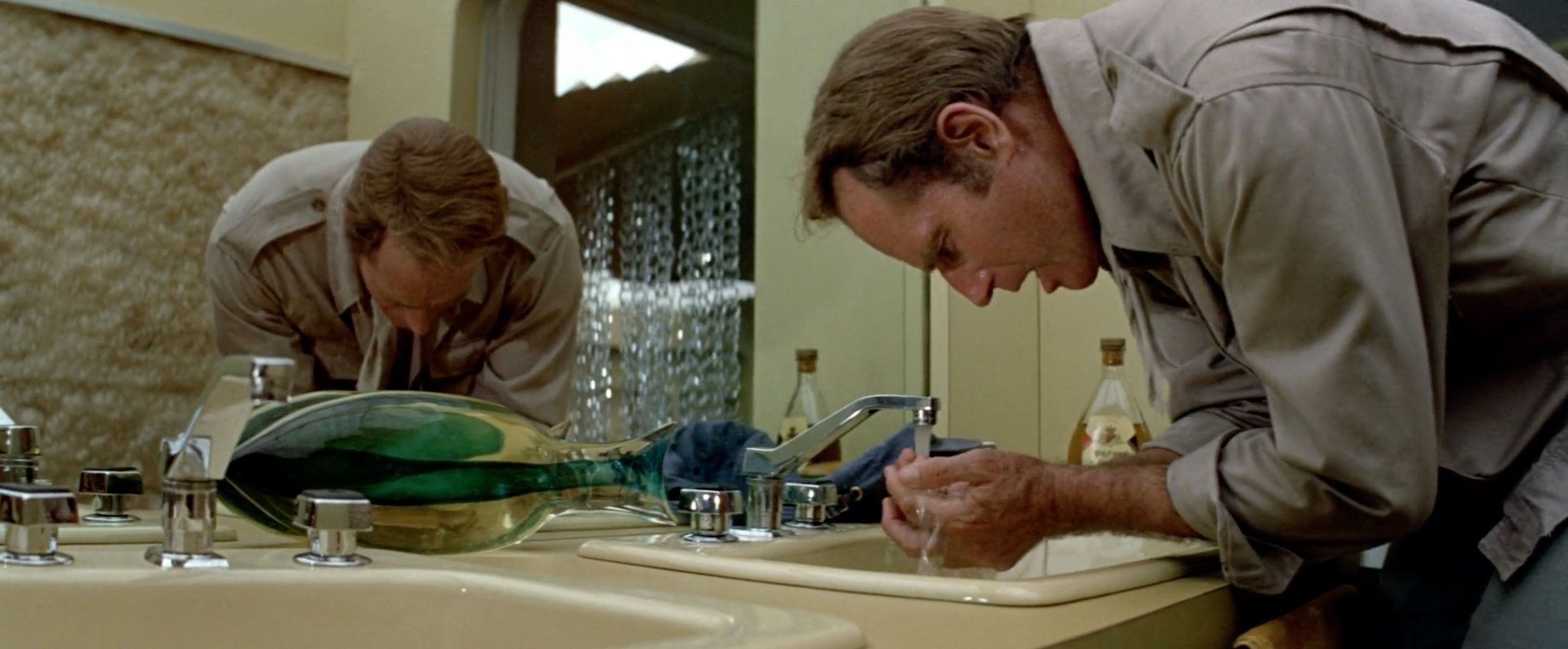 You can’t tell from this screen grab, but this is, I believe, the only handheld shot in the movie. For the life of me, I can’t figure out why it was handheld. If it’s a set, and I don’t know why it wouldn’t be, why couldn’t they remove the walls to fit the camera in there? Then again, I’m not a director, so what do I know.
You can’t tell from this screen grab, but this is, I believe, the only handheld shot in the movie. For the life of me, I can’t figure out why it was handheld. If it’s a set, and I don’t know why it wouldn’t be, why couldn’t they remove the walls to fit the camera in there? Then again, I’m not a director, so what do I know.
Okay! So that take the somewhat outdated visual style, one that I think implicitly promises comfort and familiarity, and marry that to a Blade Runner- or Children of Men-type scenario. A reluctant protagonist, caught between two worlds, pursues a goal while navigating a rich, detailed world. Already that’s a little odd, but then make that world one of crushing overpopulation, scant resources, the extinction of nature, franchise-like suicide centers, legalized sexual slavery, and food riots, well, to misuse an Arrested Development quote, baby, you got a stew goin’. The clash of form and content causes a kind of mental whiplash, highlighting the horrible and depressing elements in a way that might not hit as hard in a more modern style. But maybe that’s just me. Maybe I feel the cinematic style promising some kind of relief that never comes.
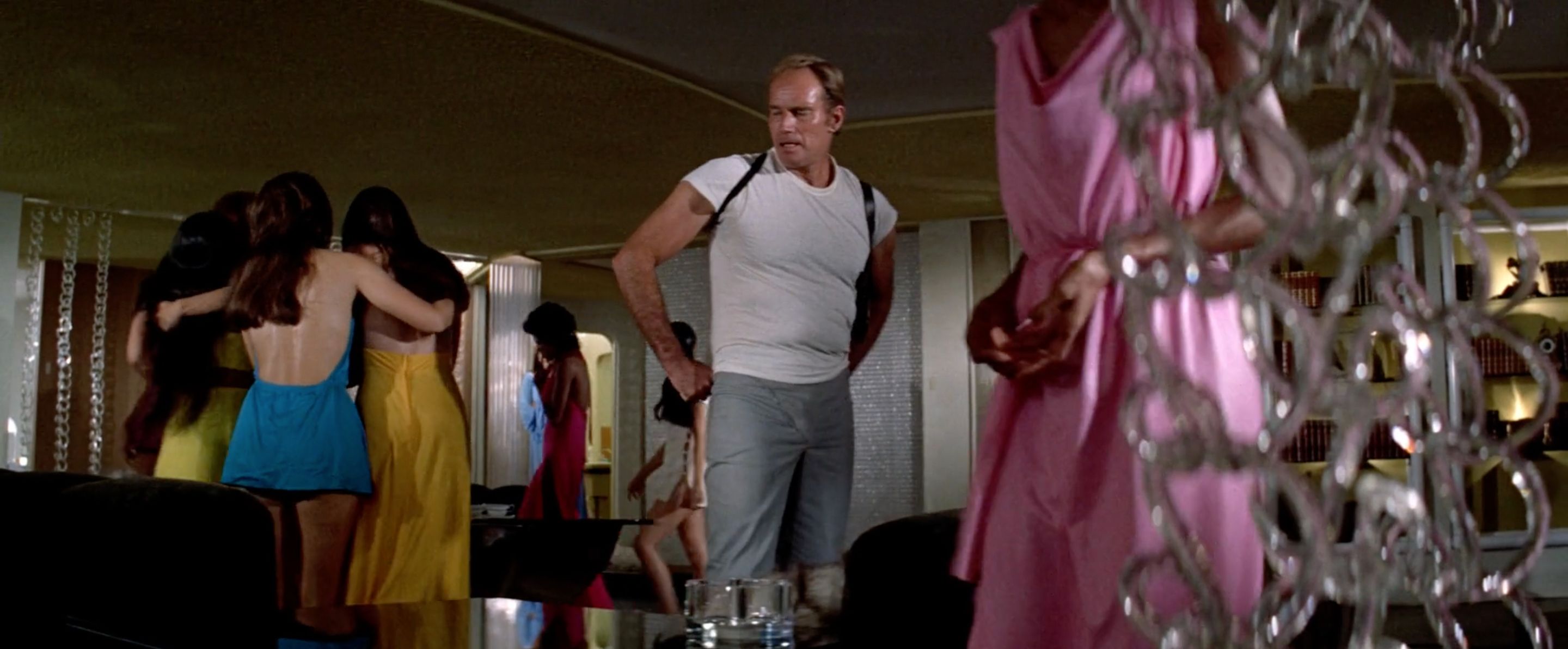 “Furniture.” This is also a good example of the kind of widescreen mise en scene that feels so wrong in this dystopic context, yet so right.
“Furniture.” This is also a good example of the kind of widescreen mise en scene that feels so wrong in this dystopic context, yet so right.
And the relief most certainly does not come. And this ultimately is what makes it great — it’s heartbreaking. It’s heartbreaking not so much for the twist — which, frankly, doesn’t hit as hard as it thinks it does2 — but for seeing how hopeless it all is for these characters. Nothing is going to get better. Fish are extinct. A dead woman lies on the ground outside a church/orphanage, with her crying child tied to her wrist. Watching footage of now nonexistent animals and landscapes while dying of lethal injection is probably as good as it gets. “Soylent green is people!” cries Heston as he’s carted away, but it never feels like the key that will unlock some kind of revolution. It’s just another indignity among many.
Movies where the Earth is destroyed by a rogue comet or whatever are depressing, but at least that’s an ending. Soylent Green suggests that all this will keep going and going and going until maybe, maybe it all ends with a whimper.
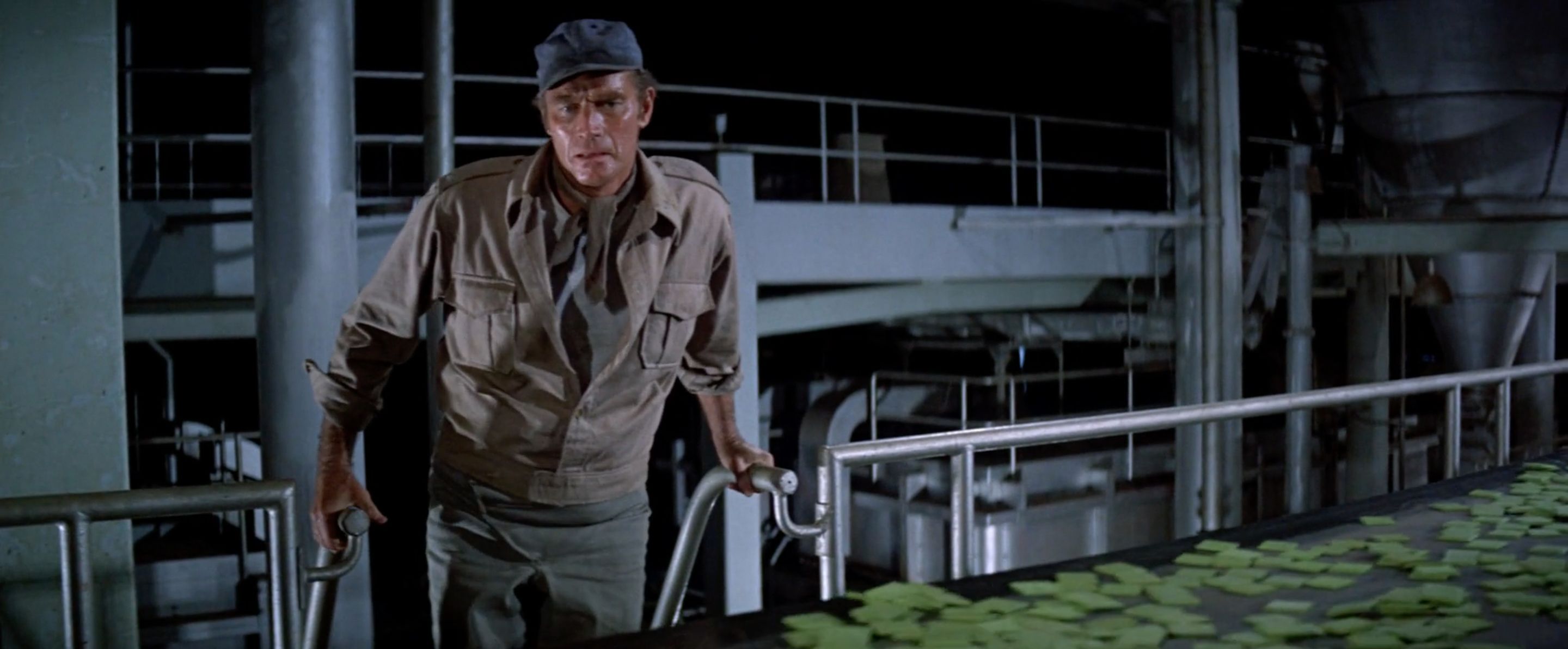 Not gonna lie, these look delicious.
Not gonna lie, these look delicious.
How many stars out of five? Four and a half. If you’ve never seen it, give it a shot.
Where can I stream it? As of this writing3, you can’t stream it for free, but you can rent or buy it from Amazon, Apple, YouTube, DirecTV, Vudu, Microsoft Store, Google Play, and Redbox.
What can we take from it? Last week, I introduced the concept of Patrons to Against the ’70s, complete with incomplete rules. My apologies for that. My only consolation is that I will return to Patrons often this year, expanding and clarifying the rules until I have something solid.
With that in mind… I’m doing it again.
No Patrons today, though. Soylent Green is a great movie, but as far as offering ideas to adapt for rpgs, that’s a tougher row to hoe. What am I going to do, stat up the Scoops? (They’re level 3 creatures and if you get hit, you lose a turn as you get deposited into the truck bed. They should be tough enough to deal with NPC “normies” but weak enough for PCs to ravage.) No, I needed something different this week. And so I introduce to this audience the Cypher System concept known as “Genre.”
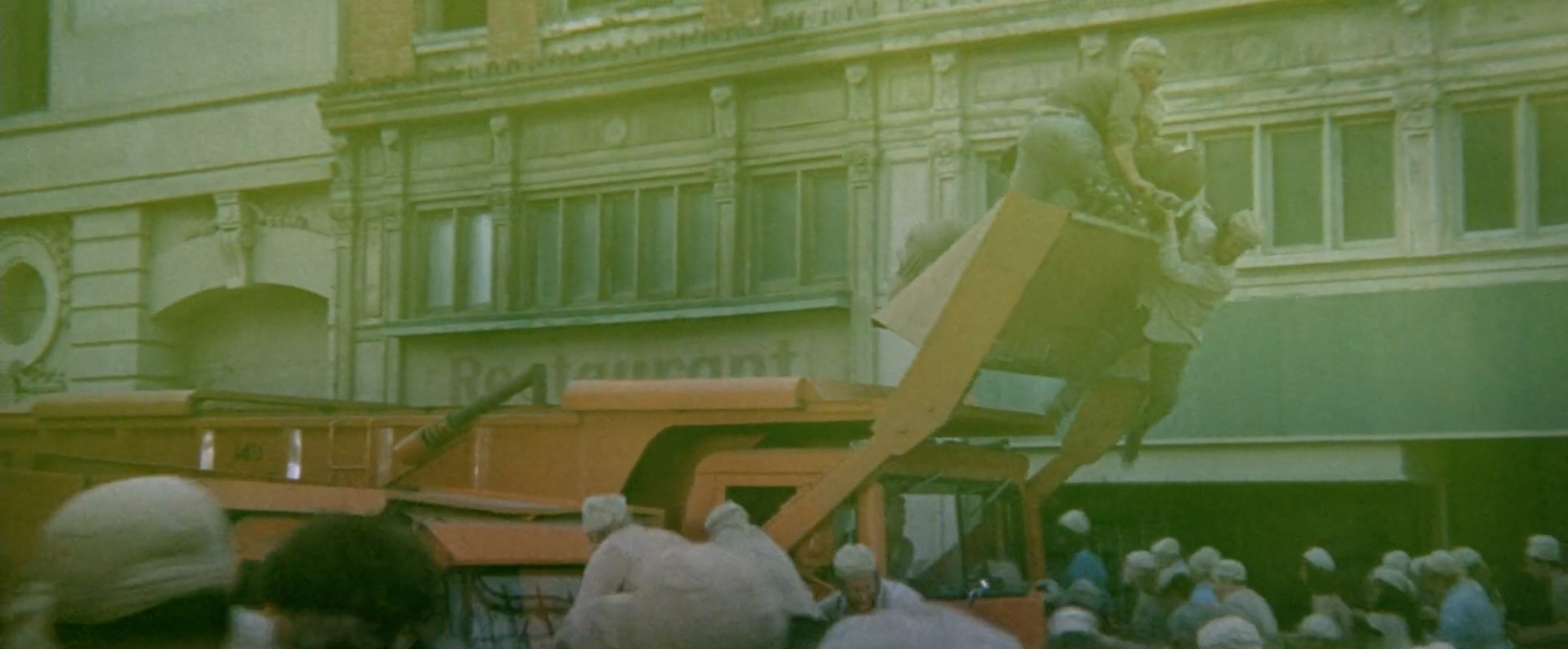 Make stats! Make stats!
Make stats! Make stats!
Okay, you probably don’t really need to have genre explained to you. In the Cypher System, however, it means… no, it still means exactly what it sounds like. But in the Cypher System, the expression of genre has a semi-solid set of expectations behind it. It’s been formalized, more or less. So I’m going to run through some of those building blocks. In the core rule book, there are chapters on fantasy, science fiction, modern, horror, romance, super heroes, post-apocalyptic, fairy tale and historical genres. To this, I propose adding dystopia. By dystopia, I specifically mean a modern or futuristic dystopia as seen in 1970s movies. I hope my guidelines are flexible enough to cover, for example, Soylent Green and Logan’s Run.
Like the Patron rules last week, this is a work in progress, an opportunity for me to think through, on the page, some new(ish) ideas. After this first run-through, I plan to expand and develop these ideas further, and then publish them as a free4 download.
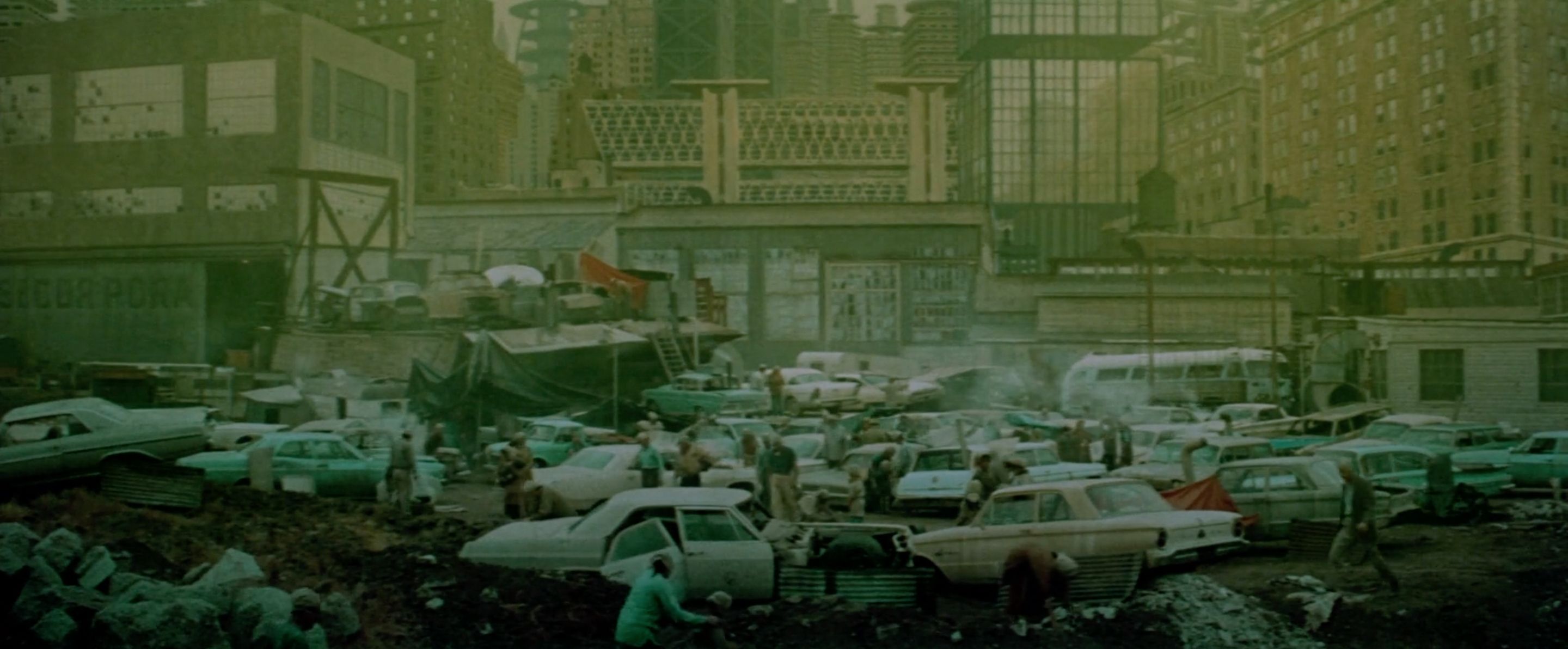 DYSTOPIA
DYSTOPIA
The dystopic genre setting could probably be described as falling between the Cypher System’s modern setting and post-apocalyptic setting. There are a number of similarities between dystopic and post-apocalyptic settings, but the differences are distinct5. In a post-apocalyptic setting, it is generally assumed that people are trying to rebuild civilization with varying degrees of success, while in a dystopic one, civilization is usually quite advanced, but also often on the verge of collapse. In a post-apocalyptic setting, outposts of civilization can be friendly or hostile, good or bad, but this is usually a function of the individuals within them. In a dystopic setting, society itself is the villain; it could be argued that the individuals who enforce the rules of that society are just as much victims as anyone else6. Finally, in a post-apocalyptic setting, finding and keeping resources is usually an important part of the game. However, in a dystopic7 setting, even in a Soylent Green-inspired game world, where common items are more valuable than gold, resource management shouldn’t be an issue.
CREATING A DYSTOPIC SETTING
Creating a dystopia is difficult. All happy settings are alike; each dystopic setting is dystopic in its own way. While there are potentially as many different kinds of dystopias as there are imaginations, for the purpose of a game, our dystopias will have four broad categories. First, what is the method of societal control? Is it based on technology, like in THX-1138? Is it a world overwhelmed with bureacracy (Brazil) or dominated by a religion or philosophy (The Handmaid’s Tale)? Do corporations set the terms of existence? This choice will flavor all the other choices. You can, of course, mix and match these qualities. However, unless your players are really interested in the details of your setting, I suggest picking one and going all-in on it, for the sake of clarity and ease of use. If there are a number of subtleties to your dystopia, I respectfully suggest you save it for a novel.
The second category is environmental disaster. Worldwide flooding? Irradiated wasteland? Virulent disease? Not all dystopias have one, but you should choose one anyway. They are a convenient for explaining the origin of the dystopia and can provide interesting physical obstacles for player characters to overcome, especially if they reach an “outside” (see below). Such physical obstacles could be things like rivers of toxic sludge or submerged city ruins, or antagonists like animals (normal or mutated) or people free from the dystopic society who might not appreciate newcomers.
The third category is injustice. Precisely how are citizens oppressed in this dystopia? What is the main thing that people can’t do? What is the punishment for doing it? Some dystopias, like in Logan’s Run, seem to offer a plethora of freedom, but at a very steep cost. Again, keep it simple, and don’t be subtle. Just fill in the blank: _________ is outlawed! Living past 30 is outlawed! Personal space is outlawed!8 Emotions are outlawed! For one day a year, laws are outlawed! Having more than one kid is outlawed! (That’s 1992’s Fortress, which is both a dystopia movie and a prison break one.) Also, be sure that this outlawed thing touches each of the player characters in some way — characters in a dystopia who aren’t actually affected by the dystopia are usually called “villains.”
Finally, most fictional dystopias have a “forbidden outside” that is supposedly free of the restrictions and oppressions of the society. These forbidden outsides give the players a goal for the game other than simply surviving or active revolution. What is the forbidden outside of this particular dystopia like? Is there a different kind of danger there? Have others from the dystopia made it there, or would the player characters be the first? The forbidden outside is potentially a place where you may want to enforce resource management. Society sucks, but at least there you can eat.
RUNNING A DYSTOPIC SETTING
The first question should be, “Why are you running this particular kind of game?” There are, no doubt, GMs and players who want to vicariously experience a fictional world that is literally defined by its shittiness. However, I’m going to assume that most people will go to the dystopia in order to get directions on how to get away from the dystopia. Therefore, the assumption here is that a) the campaign is short, or even a one-shot and b) the goal is to escape from and/or dismantle the dystopia.
So with that in mind, build from the ending. How can one escape from the dystopia? How can one fuck up the system? Remember, it shouldn’t be a pre-made puzzle for the players to solve; solutions should come from them. At the same time, think about ways to get them engaged with one or both of the goals. Is there a secret society devoted to spiriting individuals away to the forbidden outside? Does one of the characters work in the central computer cortex where all the decisions are made? Don’t give the players exits; give them tools to make their own exits.
Another difficulty to keep in mind is that, in most dystopic fiction, the stakes are incredibly high and the room for error is virtually nil. One wrong move and the silver-faced police bots throw you in an empty white room with fluorescent lighting for the rest of your days. Most role-playing games, weirdly, are not very good for these kinds of all-or-nothing situations. Therefore, you need to prepare for a lot of “fail forward” situations9 — failed die rolls that don’t lead to an immediate end of game, but instead push the story forward somehow. Usually this is expressed via “and” or “but.” “You attract the attention of the police bot. It doesn’t arrest you yet, but it’s now suspicious of you. What do you do?” “Despite your poor roll, you manage to slip the piece of code into the program like you wanted… but you hear a couple of scientists outside the room, about to walk in. What do you do?” Even if the players royally screw up, take a moment before starting to think how this could be spun away from a game-ending state. If a player character gets caught, what if the police bots demand he spy for them? If the whole party gets caught, what if the police bots force them to retrieve runaways from the forbidden outside?
SAFETY FIRST
One thing to keep in mind for all rpg sessions, but I think especially for the dystopia genre, is the use of safety tools. Dystopias nearly always deal with dark, dark stuff, and unlike in horror, you (usually) can’t shoot the dark stuff or cast a spell to banish it. (Imagine, for a moment, a Handmaid’s Tale rpg and a lot of these issues become immediately apparent.) Make sure everyone at the table knows what kind of topics are likely in your game, and make sure everyone is on board — and if they’re not, see if those topics can be altered in some way. Safety tools, such as “lines and veils” (topics that cannot be broached and those that can be handled “off-screen” or abstractly), and the X Card (a physical card raised to indicate discomfort) can be used to help manage these topics and the expectations around them.
For a good primer and excellent advice on the use of safety tools, with lots of links, I recommend this post by Mike Shea a.k.a. Sly Flourish. The comfort of your players comes first!
Next time on Against the ’70s: Saturday Night Fever (1977, John Badham)
Originally published 1/19/22 on Substack.
The one big exception is when the story hinges on “rules” that aren’t obvious or intuitive. Those should be explained, since you want your audience to be able to roughly predict the future (“the rules work like this, so this will probably happen”) and then inevitably be surprised when the rules are broken (“oh shit, I didn’t see that loophole!”). This is why I don’t consider either The Matrix or Inception to have as much exposition as most people claim.↩︎
There was a futuristic rpg from 1993, heavily influenced by the comic book Marshal Law, called Underground, written by Ray Winninger, who is now in charge of D&D. [ETA 1/19/24: Winninger left Wizards of the Coast and D&D in Ocotber 2022.] Underground was about playing war veterans with super powers trying to re-adjust to society. In that world, there was a chain of restaurants called Tastee Ghoul that served human meat. Not only was cannibalism not taboo here, it was cool. Anyway, that honestly seems more like a plausible future to me. Also, people in this world would also literally sell their brains and have them replaced with computers. All of this seemed liked incredibly wild satire at the time but seems less so to me these days. For real, if you want to read some crazy shit that seems less and less crazy each year, peruse Underground’s Wikipedia page.↩︎
1/19/22↩︎
Well, free-ish. More on that soon. (ETA 1/17/24: Nope, never did any further work on this idea, and unlike Patrons, I don’t think I’ll be getting back to it any time soon. But who know, we’ll see.↩︎
The game that the Cypher System was invented for, Numenera, is post-apoc but not dystopic.↩︎
Unless they’re robots. Blow those guys up. Especially this guy.↩︎
If you’re looking for rules for indigestion, that’s a dyspeptic setting and not covered here.↩︎
Not the best description for a Soylent Green game — personal space isn’t really outlawed —but it’ll do. Also, it indicates another aspect to incorporate into your own dystopia — a class of people for whom the prohibition doesn’t apply. As might be clear by now, Soylent Green, as presented, is very difficult to render in traditional rpg terms. There is no escape here, nothing any one person can do, which is on point thematically but pretty deadly for most rpgs, which assume the player characters are heroic and proactive.↩︎
You really should prepare for failing forward in all rpgs, to be clear.↩︎
 Captain Kronos: Vampire Hunter (1974, Brian Clemens)
Captain Kronos: Vampire Hunter (1974, Brian Clemens)
 Saturday Night Fever (1977, John Badham)
Saturday Night Fever (1977, John Badham)